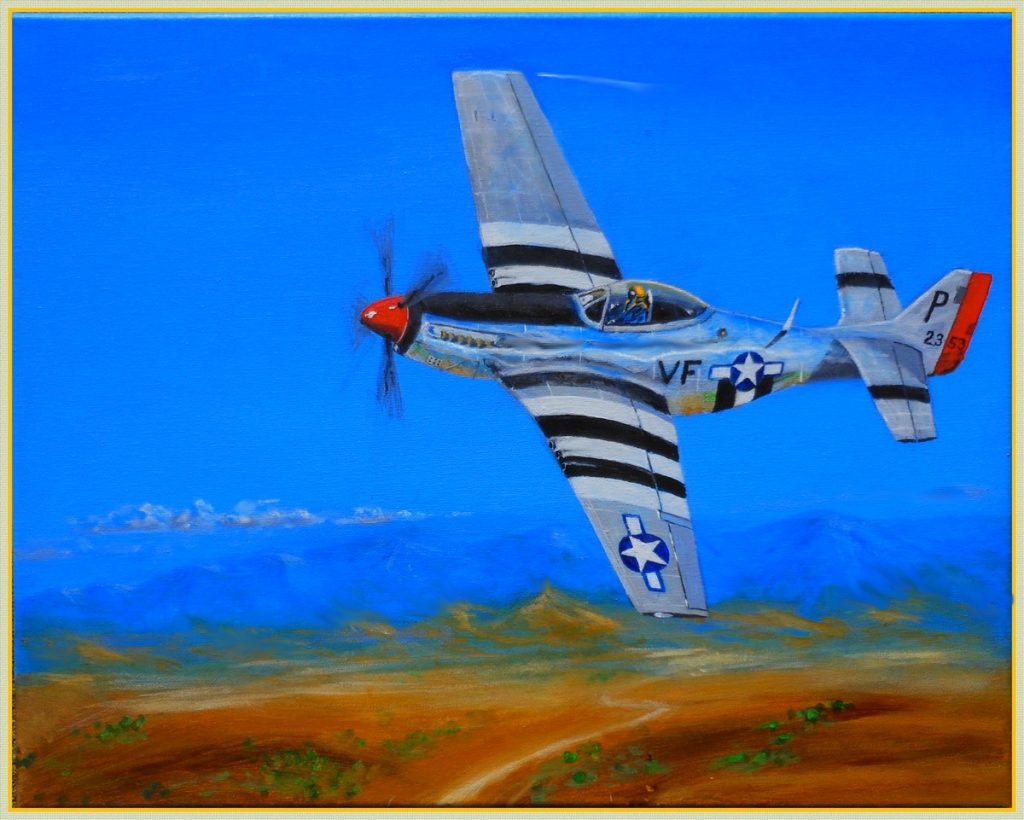by Jack
Acrylic on canvas 20X24, P51 Mustang with invasion stripes. All comments welcome!
Unique to the P-51 was the laminar flow wing design which was developed by the US National Advisory Committee for Aeronautics (NACA). Contemporary aircraft wings featured a wing cross-section with maximum thickness about a fifth of the way across the wing from the leading edge with most of the camber on top of the wing. The laminar flow wing in contrast has its maximum thickness well aft from the leading edge and has almost as much camber on top as on the bottom. This feature reduced turbulent flow across the wing, thereby reducing drag and increasing speed and range. Drag was also reduced by positioning a ventral radiator underneath the rear of the fuselage to present the smallest

possible fuselage cross section. The British Purchasing Commission was enthusiastic about the plane and confirmed a production order for 320 Mustang Is. This was later increased by 300 for NA-83s which differed only in minor details; the British designation was Mustang IA.7 Powered by the 1,100 hp Allison V-1710-39 engine, the airplane’s performance was only impressive up to 15,000 ft. However, performance would be dramatically improved once the airframe was matched with the Rolls-Royce Merlin engine. This is not to say that the Allison wasn’t a good engine as it performed very well on the Lockheed P-38. The problem with the Allison had more to do with the USAAF’s heavy reliance on turbo-supercharging.

Nice work, Jack. This one really has a sense of fluid motion, which is hard to capture.
Thanks Chris
Fascinating stuff as always.
Surely the Germans were aware of laminar flow, if for no other reason than examining downed Mustangs. I’ve always wondered why (AFAIK) they never incorporated it into their own piston driven designs.
The hot air exhausting from the Mustang’s radiator actually added a few mph airspeed.
“The problem with the Allison had more to do with the USAAF’s heavy reliance on turbo-supercharging.” Don’t agree. EVERYBODY relied on some sort of supercharging for performance above 15,000 ft. The problem with the Allison engines in Europe were two fold–
1) The turbo-superchargers were not tuned specifically for those engines.
2) There were major design issues with the cooling for both the engines and the turbo inter-coolers, which caused constant problems with engine reliability. These issues were much improved by the time the “J” model came out.
Side note: Another big advantage we had was fuel production. The German aviation fuel octane rating was about 75. Our fuel rating was about 100, and later, 150. We could run smaller, lighter weight engines at much higher boost ratings. By war’s end, the Pratt & Whitney R-2800 radial engine could put out 3000 hp at full power. The performance of a 7-ton P-47 at 30,000 ft with this engine was eye-watering.
I note the low angle vertical stabilizer extension forward into the fuselage. That was a later production modification, right? I forget what that element was called but it was to modify airflow from fuselage to tail.
Some racing variants of the P-51 elongate and sweep the back of the cockpit along the top of the fuselage to a swept curve into the vertical stabilizer.
See Precious Metal
I have always found the rear of the wing to fuselage fairing connection particularly interesting. See the third photo down here —
North American P-51D Mustang in Detail